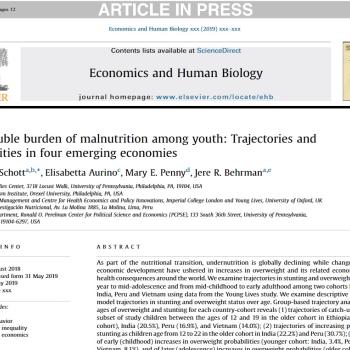Publication Information

A journal article titled 'The double burden of malnutrition among youth: Trajectories and inequalities in four emerging economies' by Whitney Schott, Elisabetta Aurino, Mary E.Penny and Jere R. Behrman has been published in Economics and Human Biology https://doi.org/10.1016/j.ehb.2019.05.009
Please find here.
Abstract
As part of the nutritional transition, undernutrition is globally declining while changes brought by economic development have ushered in increases in overweight and its related economic costs and health consequences around the world. We examine trajectories in stunting and overweight from age one year to mid-adolescence and from mid-childhood to early adulthood among two cohorts from Ethiopia, India, Peru and Vietnam using data from the Young Lives study. We examine descriptive data and then model trajectories in stunting and overweight status over age. Group-based trajectory analysis with five ages of overweight and stunting for each country-cohort reveals (1) trajectories of catch-up growth for a subset of study children between the ages of 12 and 19 in the older cohort in Ethiopia (20.1% of the cohort), India (20.5%), Peru (16.9%), and Vietnam (14.0%); (2) trajectories of increasing probabilities of stunting as children age from 12 to 22 in the older cohort in India (22.2%) and Peru (30.7%); (3) trajectories of early (childhood) increases in overweight probabilities (younger cohort: India, 3.4%, Peru, 19.4%, and Vietnam, 8.1%), and of later (adolescence) increases in overweight probabilities (older cohort: Ethiopia, 0.5%, India, 6.3%, Peru, 40.9%, and Vietnam, 9.4%). Multinomial logit prediction of membership in trajectory categories reveals that higher wealth quartiles and maternal schooling are protective against high stunting probability trajectory group membership, but higher wealth and urban residence predict high overweight probability trajectory group membership. This evidence suggests a window of opportunity for interventions to reduce stunting and to avert overweight development in adolescence, in addition to the often-emphasized first 1000 days after conception. A life-course approach to policies and programs to target both undernutrition and overweight should be considered.

A journal article titled 'The double burden of malnutrition among youth: Trajectories and inequalities in four emerging economies' by Whitney Schott, Elisabetta Aurino, Mary E.Penny and Jere R. Behrman has been published in Economics and Human Biology https://doi.org/10.1016/j.ehb.2019.05.009
Please find here.
Abstract
As part of the nutritional transition, undernutrition is globally declining while changes brought by economic development have ushered in increases in overweight and its related economic costs and health consequences around the world. We examine trajectories in stunting and overweight from age one year to mid-adolescence and from mid-childhood to early adulthood among two cohorts from Ethiopia, India, Peru and Vietnam using data from the Young Lives study. We examine descriptive data and then model trajectories in stunting and overweight status over age. Group-based trajectory analysis with five ages of overweight and stunting for each country-cohort reveals (1) trajectories of catch-up growth for a subset of study children between the ages of 12 and 19 in the older cohort in Ethiopia (20.1% of the cohort), India (20.5%), Peru (16.9%), and Vietnam (14.0%); (2) trajectories of increasing probabilities of stunting as children age from 12 to 22 in the older cohort in India (22.2%) and Peru (30.7%); (3) trajectories of early (childhood) increases in overweight probabilities (younger cohort: India, 3.4%, Peru, 19.4%, and Vietnam, 8.1%), and of later (adolescence) increases in overweight probabilities (older cohort: Ethiopia, 0.5%, India, 6.3%, Peru, 40.9%, and Vietnam, 9.4%). Multinomial logit prediction of membership in trajectory categories reveals that higher wealth quartiles and maternal schooling are protective against high stunting probability trajectory group membership, but higher wealth and urban residence predict high overweight probability trajectory group membership. This evidence suggests a window of opportunity for interventions to reduce stunting and to avert overweight development in adolescence, in addition to the often-emphasized first 1000 days after conception. A life-course approach to policies and programs to target both undernutrition and overweight should be considered.

